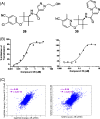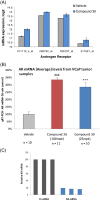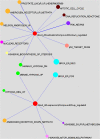Dose-dependent effects of small-molecule antagonists on the genomic landscape of androgen receptor binding
- PMID: 22849360
- PMCID: PMC3507642
- DOI: 10.1186/1471-2164-13-355
Dose-dependent effects of small-molecule antagonists on the genomic landscape of androgen receptor binding
Abstract
Background: The androgen receptor plays a critical role throughout the progression of prostate cancer and is an important drug target for this disease. While chromatin immunoprecipitation coupled with massively parallel sequencing (ChIP-Seq) is becoming an essential tool for studying transcription and chromatin modification factors, it has rarely been employed in the context of drug discovery.
Results: Here we report changes in the genome-wide AR binding landscape due to dose-dependent inhibition by drug-like small molecules using ChIP-Seq. Integration of sequence analysis, transcriptome profiling, cell viability assays and xenograft tumor growth inhibition studies enabled us to establish a direct cistrome-activity relationship for two novel potent AR antagonists. By selectively occupying the strongest binding sites, AR signaling remains active even when androgen levels are low, as is characteristic of first-line androgen ablation therapy. Coupled cistrome and transcriptome profiling upon small molecule antagonism led to the identification of a core set of AR direct effector genes that are most likely to mediate the activities of targeted agents: unbiased pathway mapping revealed that AR is a key modulator of steroid metabolism by forming a tightly controlled feedback loop with other nuclear receptor family members and this oncogenic effect can be relieved by antagonist treatment. Furthermore, we found that AR also has an extensive role in negative gene regulation, with estrogen (related) receptor likely mediating its function as a transcriptional repressor.
Conclusions: Our study provides a global and dynamic view of AR's regulatory program upon antagonism, which may serve as a molecular basis for deciphering and developing AR therapeutics.
Figures






Similar articles
-
Discovery of N-(4-(Benzyloxy)-phenyl)-sulfonamide Derivatives as Novel Antagonists of the Human Androgen Receptor Targeting the Activation Function 2.J Med Chem. 2022 Feb 10;65(3):2507-2521. doi: 10.1021/acs.jmedchem.1c01938. Epub 2022 Jan 25. J Med Chem. 2022. PMID: 35077161
-
The transcriptional programme of the androgen receptor (AR) in prostate cancer.BJU Int. 2014 Mar;113(3):358-66. doi: 10.1111/bju.12415. BJU Int. 2014. PMID: 24053777 Review.
-
A competitive inhibitor that reduces recruitment of androgen receptor to androgen-responsive genes.J Biol Chem. 2012 Jul 6;287(28):23368-80. doi: 10.1074/jbc.M112.344671. Epub 2012 May 15. J Biol Chem. 2012. PMID: 22589544 Free PMC article.
-
Cell-lineage specificity and role of AP-1 in the prostate fibroblast androgen receptor cistrome.Mol Cell Endocrinol. 2017 Jan 5;439:261-272. doi: 10.1016/j.mce.2016.09.010. Epub 2016 Sep 12. Mol Cell Endocrinol. 2017. PMID: 27634452
-
Androgen receptor enhancer usage and the chromatin regulatory landscape in human prostate cancers.Endocr Relat Cancer. 2019 May;26(5):R267-R285. doi: 10.1530/ERC-19-0032. Endocr Relat Cancer. 2019. PMID: 30865928 Review.
Cited by
-
SNP rs9364554 Modulates Androgen Receptor Binding and Drug Response in Prostate Cancer.Biomolecules. 2025 Jan 4;15(1):64. doi: 10.3390/biom15010064. Biomolecules. 2025. PMID: 39858458 Free PMC article.
-
Peroxisome proliferator-activated receptor gamma controls prostate cancer cell growth through AR-dependent and independent mechanisms.Prostate. 2020 Feb;80(2):162-172. doi: 10.1002/pros.23928. Epub 2019 Nov 26. Prostate. 2020. PMID: 31769890 Free PMC article.
-
Identification of Androgen Receptor Modulators in a Prostate Cancer Cell Line Microarray Compendium.Toxicol Sci. 2018 Nov 1;166(1):146-162. doi: 10.1093/toxsci/kfy187. Toxicol Sci. 2018. PMID: 30085300 Free PMC article.
-
Decoding the Inversion Symmetry Underlying Transcription Factor DNA-Binding Specificity and Functionality in the Genome.iScience. 2019 May 31;15:552-591. doi: 10.1016/j.isci.2019.04.006. Epub 2019 Apr 6. iScience. 2019. PMID: 31152742 Free PMC article.
-
Transcriptional Regulation in Prostate Cancer.Cold Spring Harb Perspect Med. 2018 Nov 1;8(11):a030437. doi: 10.1101/cshperspect.a030437. Cold Spring Harb Perspect Med. 2018. PMID: 29530947 Free PMC article. Review.
References
-
- Koivisto P, Kononen J, Palmberg C, Tammela T, Hyytinen E, Isola J, Trapman J, Cleutjens K, Noordzij A, Visakorpi T. K: Androgen receptor gene amplification: a possible molecular mechanism for androgen deprivation therapy failure in prostate cancer. Cancer Res. 1997;57:314–319. - PubMed
-
- Visakorpi T, Hyytinen E, Koivisto P, Tanner M, Keinänen R, Palmberg C, Palotie A, Tammela T, Isola J. K: vivo amplification of the androgen receptor gene and progression of human prostate cancer. Nat Genet. 1995;4:401–406. - PubMed
MeSH terms
Substances
LinkOut - more resources
Full Text Sources
Other Literature Sources
Molecular Biology Databases
Research Materials

